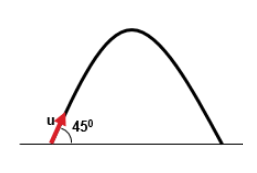
A particle of mass m is projected with a velocity u making an angle ${45^ \circ }$ with the horizontal from level ground. When the particle lands on the level ground the magnitude of the change in momentum will be:
A. $mu\sqrt 2 $
B. zero
C. $2mu$
D. $\dfrac{{mu}}{{\sqrt 2 }}$
Answer
564k+ views
Hint: In this question,we are going to apply the concept of momentum and it is defined as the product of mass and velocity of a particle in motion. It is denoted by using letter p and its SI unit is $kgm{s^{ - 2}}$. It is a vector quantity (it has both magnitude and direction).
Complete step by step answer:

The particle’s initial vertical velocity is $u\sin 45 = \dfrac{u}{{\sqrt 2 }}$. Since the particle is coming back to its initial position (i.e. to the level ground) we can say that its final vertical velocity is also $\dfrac{u}{{\sqrt 2 }}$. But the final vertical velocity will be in a direction opposite to that of the initial vertical velocity.
The initial vertical velocity is $ + \dfrac{u}{{\sqrt 2 }}m{s^{ - 1}}$ whereas the final vertical velocity will be $ - \dfrac{u}{{\sqrt 2 }}m{s^{ - 1}}$.
Since this is a projectile motion, the horizontal component of the velocity remains constant.
Total change in momentum is the sum of change in momentum along the x and y axis.
$
\Delta p = \Delta {p_x} + \Delta {p_y} \\
\Rightarrow \Delta {p_y} = m\left( { + \dfrac{u}{{\sqrt 2 }}} \right) - m\left( { - \dfrac{u}{{\sqrt 2 }}} \right) \\
\Rightarrow \Delta {p_y} = 2m\left( {\dfrac{u}{{\sqrt 2 }}} \right) \\
\Rightarrow \Delta {p_y} = \sqrt 2 mu \\
\Delta {p_x} = m{u_x} - m{u_x} = 0 \\
\Rightarrow \Delta p = \Delta {p_x} + \Delta {p_y} \\
\Rightarrow \Delta p = 0 + \sqrt 2 mu \\
\therefore \Delta p = mu\sqrt 2 \\
$
Hence the net change in momentum in this case is $mu\sqrt 2 $.
Therefore the correct choice is option (A).
Note: Here we say that the horizontal velocity remains the same by ignoring the drag forces. If we consider the drag forces, then the horizontal velocity will vary and so will the horizontal momentum.
Complete step by step answer:

The particle’s initial vertical velocity is $u\sin 45 = \dfrac{u}{{\sqrt 2 }}$. Since the particle is coming back to its initial position (i.e. to the level ground) we can say that its final vertical velocity is also $\dfrac{u}{{\sqrt 2 }}$. But the final vertical velocity will be in a direction opposite to that of the initial vertical velocity.
The initial vertical velocity is $ + \dfrac{u}{{\sqrt 2 }}m{s^{ - 1}}$ whereas the final vertical velocity will be $ - \dfrac{u}{{\sqrt 2 }}m{s^{ - 1}}$.
Since this is a projectile motion, the horizontal component of the velocity remains constant.
Total change in momentum is the sum of change in momentum along the x and y axis.
$
\Delta p = \Delta {p_x} + \Delta {p_y} \\
\Rightarrow \Delta {p_y} = m\left( { + \dfrac{u}{{\sqrt 2 }}} \right) - m\left( { - \dfrac{u}{{\sqrt 2 }}} \right) \\
\Rightarrow \Delta {p_y} = 2m\left( {\dfrac{u}{{\sqrt 2 }}} \right) \\
\Rightarrow \Delta {p_y} = \sqrt 2 mu \\
\Delta {p_x} = m{u_x} - m{u_x} = 0 \\
\Rightarrow \Delta p = \Delta {p_x} + \Delta {p_y} \\
\Rightarrow \Delta p = 0 + \sqrt 2 mu \\
\therefore \Delta p = mu\sqrt 2 \\
$
Hence the net change in momentum in this case is $mu\sqrt 2 $.
Therefore the correct choice is option (A).
Note: Here we say that the horizontal velocity remains the same by ignoring the drag forces. If we consider the drag forces, then the horizontal velocity will vary and so will the horizontal momentum.
Recently Updated Pages
Master Class 8 Maths: Engaging Questions & Answers for Success

Class 8 Question and Answer - Your Ultimate Solutions Guide

Master Class 7 Maths: Engaging Questions & Answers for Success

Class 7 Question and Answer - Your Ultimate Solutions Guide

Master Class 6 Maths: Engaging Questions & Answers for Success

Class 6 Question and Answer - Your Ultimate Solutions Guide

Trending doubts
What is meant by exothermic and endothermic reactions class 11 chemistry CBSE

Which animal has three hearts class 11 biology CBSE

10 examples of friction in our daily life

One Metric ton is equal to kg A 10000 B 1000 C 100 class 11 physics CBSE

1 Quintal is equal to a 110 kg b 10 kg c 100kg d 1000 class 11 physics CBSE

Difference Between Prokaryotic Cells and Eukaryotic Cells




